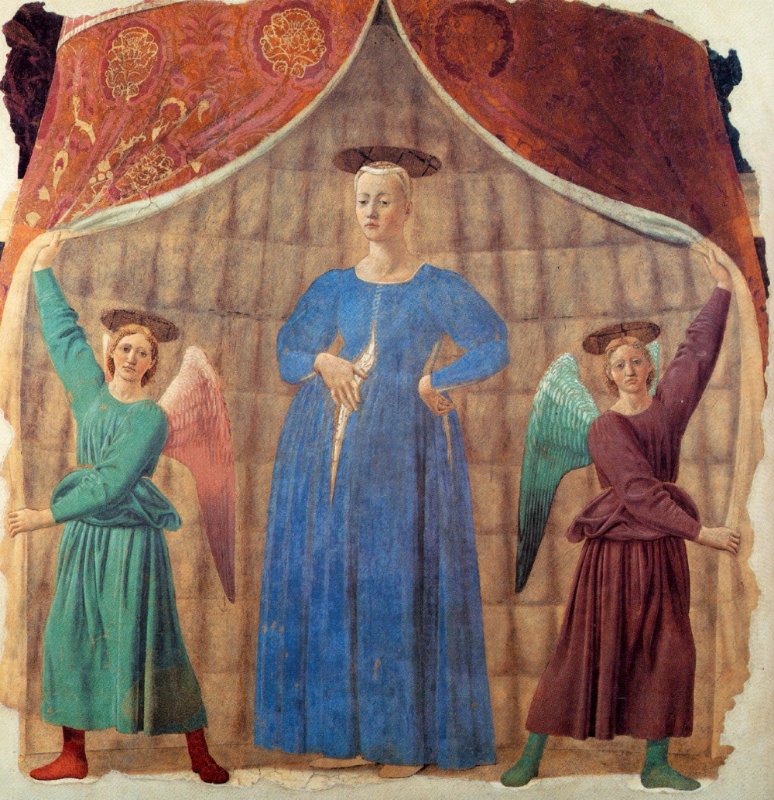Anghiari and beyond
Anghiari
Anghiari is a 10-minute drive from Le Stabbielline. It is surrounded by thirteenth-century walls and enjoys incredible views over the Tiber valley. A famous battle between Florentine forces and Milan which became the subject of a lost Leonardo masterpiece is commemorated in one of the town’s three museums. There is a lively programme of events throughout the year: an antiques market on the second Sunday of most months, Wednesday night fiestas throughout the summer, an annual visit from the Southbank Sinfonia in July, the ‘Intrepida’ bike ride in the autumn – and more. But Anghiari has kept its character. Stop for a coffee in Bar Baldaccio or an aperol in Cafe Garribaldi or queue with the locals for possibly the best pizza in Italy at al Cantucci0 and you’ll fall in love with Anghiari as we have.
La Madonna del Parto
There are two big, essential sites close to Le Stabbielline on what is known as the ‘Piero trail’ – a route to view the great masterpieces of early Renaissance painter Piero della Francesca. The first is the church of San Francesco in Arezzo with his famous cycle of frescoes, the Legend of the True Cross. The second is the Civic Museum in Sansepolcro, home to The Resurrection, which Aldous Huxley once called “the greatest picture in the world”. But for others, that accolade is taken by his pregnant madonna, kept in its own small museum in nearby Monterchi. Painted in seven days and featuring a large extent of blu oltremare obtained from lapis lazuli imported from Afghanistan by the Venetian republic, it is impossibly beautiful.
Arezzo
Drive over the hills to ancient Arezzo to find world class art – including Piero della Francesca’s famous frescoes – plus no little style and sophistication. Escalators take you from parking outside the northern walls to the majestic Cathedral of Saint Donatus. From there it is a walk down the beautiful Corso Italia to the medieval Piazza Grande or chic shopping at Sugar. If possible, visit on the first Sunday of the month for an antiques market that its righty hailed as one of the country’s best.
The Burri collection
Even if you are sated by Renaissance paintings, make a point of visiting this collection of works by the great post-war Italian artist Alberto Burri, sensationally housed in a number of old tobacco sheds on the southern edge of Citta di Castello. Covering 11,500 square meters, the structure itself represents a final attempt by Burri to create a total work of art. Inside you will find a spectacular collection of large cycles of paintings.
You might equally easily visit any number of historic and beautiful towns: Siena or Cortona to the west; Perugia and/or Assisi to the south; Gubbio to the south-east; or Urbino over the mountains in the direction of the coast (where at places like Fano, you’ll find classic Italian beach scenes, although a day trip might be stretch). There are plenty of guidebooks at Le Stabbielline.
Florence
Easily accessible, and even in high summer – when the heat and the tourists threaten to be overwhelming – the birthplace of the Renaissance is a magical place. Book to visit the Uffizi in advance, seek sanctuary in the Boboli gardens or search out Vivoli for an ice cream – or head away from the crowds: there is such a wealth of treasures to discover in Florence, as well as excellent places to eat.
La Verna
Drive up into the hills beyond Caprese Michelangelo (birthplace of the artist) and you will discover this religious sanctuary. The Mount of La Verna was given to St. Francis in 1213 and it is still “really isolated and wild and perfect for those who want to do penance in a remote place or to those who want to live in solitude”, as it was described to Francis by his donor. You’ll find pilgrims as well as a working community of monks in the small collection of buildings, as well as wonderful countryside and some great walks,






